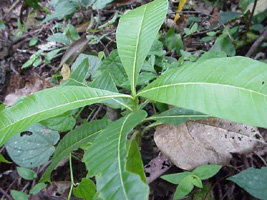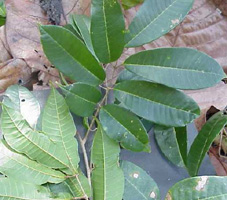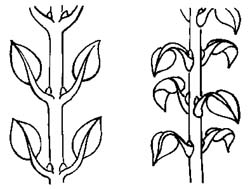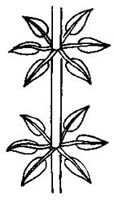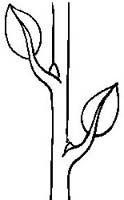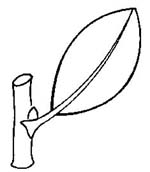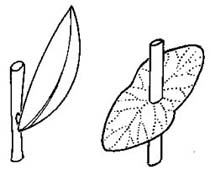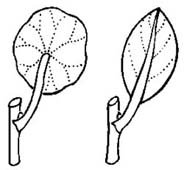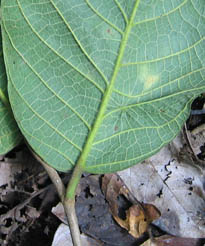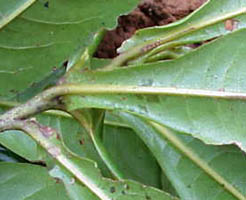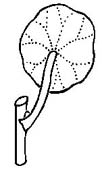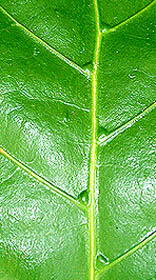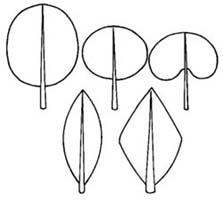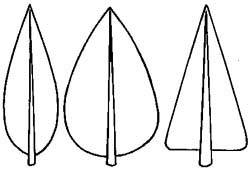This feature records the length of the leaf lamina (blade) (in cm) from the base (at point of attachment of the petiole, when petiole attached to base of leaf blade) to the leaf apex, or the longest axis of peltate leaves
Leaves (lamina width, in cm)
This feature records the width of the leaf lamina (blade) (in cm) at its widest part. This measurement is taken at right angles to the mid-vein or the medial (central) axis of the lamina when the mid-vein is absent or not visible
Leaves symmetry at base
This feature describes the symmetry of the base of the leaf lamina (blade) on either side of the central vein/axis as being either:
| very asymmetric |
symmetric |
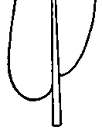 |
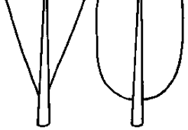 |
Leaves with margin toothing
| This feature describes the presence or absence of teeth on the margin of the leaf lamina (blade). The margin is described as: | |
| entire - lacking teeth, usually smooth |
crenate - teeth shallow/small and rounded |
serrate to dentate (toothed) - more or less strongly/distinctly and sharply toothed |
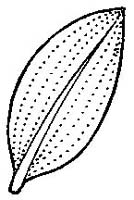 |
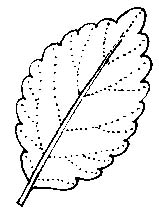 |
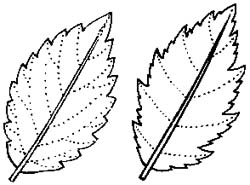 |
| Note: this feature should not be confused with whether or not the leaves are dissected or lobed, or whether the leaf margin is undulate |
Leaves dissected or lobed
| This feature describes the presence or absence of lobing on the margin of the leaf blade (lamina). |
The margin is described as:
| dissected or lobed |
not dissected or lobed |
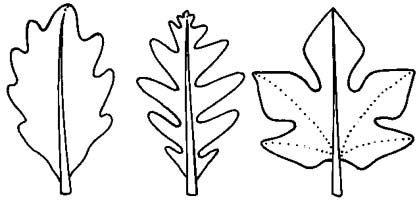 |
 |
| Note: No distinction is made between dissected and lobed leaves. Also, this feature should not be confused with whether the margin of the leaf lamina (blade) is entire or variously toothed, or whether the leaf margin is undulate |
Leaves dissection type
When the leaf blade (lamina) is dissected or lobed, the lobing/dissection is described as either:
| pinnately lobed |
palmately lobed |
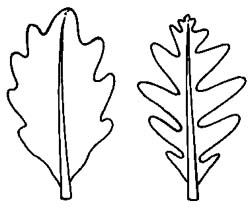 |
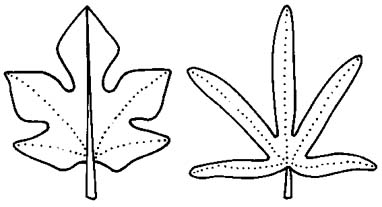 |
Leaves shape of apex
| The shape of the apex of the leaf lamina (blade) is described as: |
| emarginate or retuse - having notch at the apex or ending in a rounded apex with a rounded sinus (cavity) at the centre
|
rounded - apex rounded like an arc of a circle
|
obtuse - apex gradually ending in a rounded blunt point
|
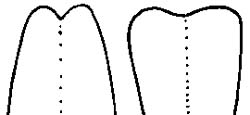 |
 |
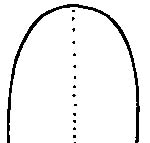 |
| acute - should be sharp to touch like the point a needle , apex with two almost straight sides
|
mucronate - lamina ending abruptly by a hard short point
|
long-tapering - apex gradually ending in a long reducing point
|
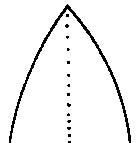 |
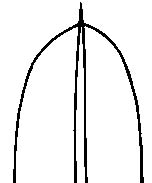 |
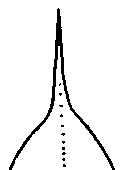
|
Compound Leaves
Leaves when compound, leaf form
| When the plant has compound leaves, the type of leaves are recorded as: |
| with one leaflet (unifoliate) - a compound leaf reduced to a single leaflet. Compound leaves that consist of a single leaflet are often difficult to distinguish from simple leaves. They are usually recognised by the articulated or jointed ‘petiole’, which is actually a petiole plus a petiolule. |
with two leaflets (bifoliate) - these compound leaves are referred to as bifoliate |
with three leaflets (trifoliate) - these compound leaves are referred to as trifoliate |
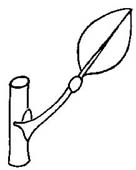 |
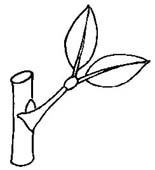 |
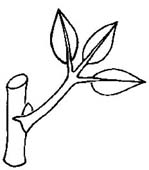 |
| pinnate - more than three leaflets and the leaflets are arranged along an unbranched rachis (axis of the leaf) |
bipinnate - more than three leaflets. This is similar to pinnate, except the rachis is branched once
| multiply compound - this type of compound leaf has more than two orders of branching before leaflets are formed
|
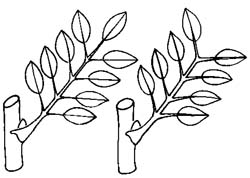 |
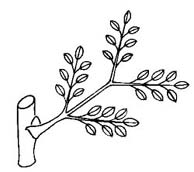 |
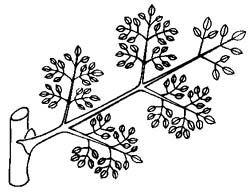 |
| palmate - this type of compound leaf has more than three leaflets attached at one point to the stalk |
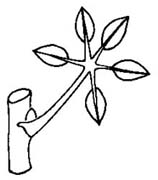 |
Petiolule of leaflet, swollen or not
| The petiolule is the stalk of a leaflet in compound leaves. This feature records the presence or absence of a swelling at either end of the petiolule.
The petiolule is recorded as either:
|
not swollen
- approximately the same diameter or width throughout length of petiolule |
| swollen at tip, or base, or both |
 |
Rachis presence
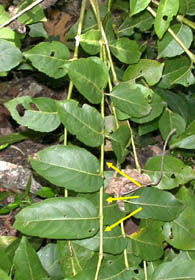
|
The rachis is here used to describe the presence or absence of a stalk-like axis of a compound leaf. It is either:
absent, or
present
Note: the rachis is regarded as absent for compound leaves with only one, two or three leaflets, and for palmate compound leaves that have more than three leaflets attached at one point
|
Rachis wings
| When the rachis is present, this feature records the presence or absence of a wing along the axis of the rachis.
The rachis is either: |
absent
- such that rachis not winged |
or
present
- winged |
 |
Rachis swelling
| When the rachis is present, this feature records the presence or absence of a swelling at either end of the rachis.
The rachis is either: |
absent
- not swollen, more or less the same diameter/width throughout
|
or
present
- with rachis swollen at either end
|
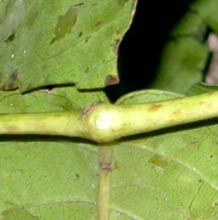
|
Leaves when compound, paripinnate or imparipinnate
| When the tree has pinnate compound leaves, this feature describes the presence or absence of a terminal leaflet.
The values for this feature are either:
|
| without a terminal leaflet (paripinnate - there is an even number of leaflets and such compound leaves are referred to as paripinnate
|
with a terminal leaflet (imparipinnate) - there is an odd number of leaflets with one leaflet inserted at the apex of the compound leaves. Such compound leaves are referred to as imparipinnate
|
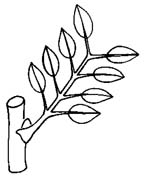
| 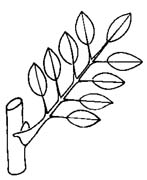
|
Leaves when compound, leaflet lamina shape type
This feature describes the shape of the leaflet blade (lamina) based on the position of its widest part.
The values include: |
| broadest above middle - equivalent to oblanceolate, obovate, spathulate, and other similar shapes |
broadest at or near middle - equivalent to elliptic, oval, and other similar shapes
|
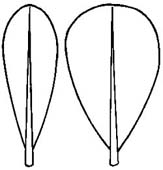 |
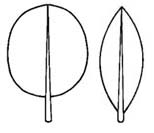 |
| broadest below middle - equivalent to lanceolate, ovate, and other similar shapes |
equally broad throughout much of length - equivalent to oblong, strap-like, and other similar shapes
|
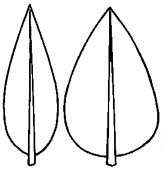 |
 |
Leaves when compound, leaflet lamina length (cm)
| This feature records the length of the leaflet lamina (blade) (in cm) from the base (at point of attachment of the petiolule) to the leaflet apex
|
Leaves when compound, leaflet lamina width (cm)
| This feature records the width of the leaflet lamina (blade) (in cm) at its widest part. This measurement is taken at right angles to the mid-vein or the medial (central) axis of the lamina when the mid-vein is absent or not visible
|
Leaves when compound, leaflets arrangement
This feature describes how the leaflets are inserted on to the rachis.
The feature records the arrangement as either: |
| leaflets opposite - leaflets arranged in pairs, opposite one another on the rachis |
leaflets alternate - leaflets occurring singly along the rachis and alternating from one side of the axis to the other
| leaflets inserted at one point of the leaf axis - leaflets in palmatifid arrangement or appearing whorl-like |
 |
 |

|
Leaves when compound, leaflet symmetry, at base
| This feature describes the symmetry of the base of the leaflet blade (lamina) on either side of the central vein/axis as being either: |
| asymmetric |
symmetric |
 |
 |
Leaves when compound and imparipinnate, terminal leaflet buds
When the compound leaves are terminated by a single leaflet (that is, imparipinnate), then the apex of the compound leaf has the following values:
|
terminal developing leaflet buds curled back on itself
terminal developing leaflet buds straight
terminal developing leaflet buds absent
|
Place mouse over the blue words to view image of example

|
There is a problem with Kingiodendron novoguineense Verdc. This species is paripinnate but it can have only 1-leaflet. Therefore, this species is also recorded as 'terminal developing leaflet buds absent' and 'terminal developing leaflet buds straight'
Venation
Venation, layout of secondary veins on leaf/leaflet
This features describes the arrangement of the secondary veins on the leaves or leaflets (for compound leaves).
The values recorded for this feature include:
|
single-veined
the leaf or leaflet with only one vein
pinnate
secondary veins arising from the midrib along its length. The venation of Calophyllum species is scored as pinnate.
trinerved
three large veins arising from the base
palmate
more than three large veins arising from the base
parallel-veined
numerous small veins running in parallel from base, not arising from a midrib. The venation of Araucaria hunsteiniiis scored as parallel-veined.
|

Place mouse over the blue words to view image of example
|
Secondary veins (open or closed)
This feature describes the closeness of the secondary veins as either:
open
spaced far apart to easily see tertiary veins |
closed
spaced so close together that tertiary veins cannot be easily seen between them. For example, the close secondary veins in Calophyllum species |
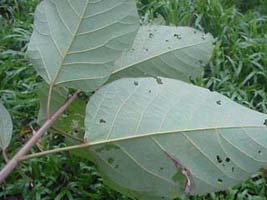
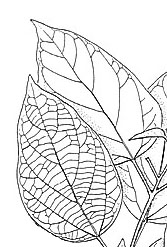 |
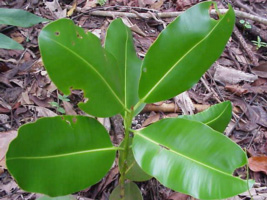
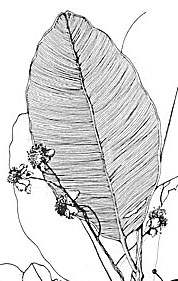 |
Secondary veins prominence
This feature describes the distinctiveness/visibility of the secondary veins as:
prominent
not prominent, but visible
not visible
Intramarginal veins presence
This feature records the presence or absence of an intramarginal vein.
The value of this feature is either:
| present |
absent |
 |
 |
Stipules
Stipules presence
This feature records the presence or absence of stipules at the base of the leaf. Since the stipules may not be persistent, there presence may be indicated by the presence of stipular scars.
This feature is recorded as either:
absent, or
present
Stipules freedom
When present, the stipules are either:
| free from one another |
joined to each other |
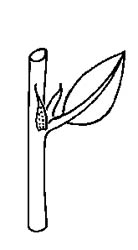 |
 |
Stipules position
The position of the stipules are recorded as either:
joined across twigs and so growing
between opposite leaves and
leaving a scar between them
when they fall; hence, interpetiolar |
laterally placed
whether free from each other
or joined together |
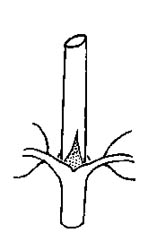 |
 |
Stipules encircling twig
When stipules are present, they may be either:
encircling the twig
(amplexicaul) |
not encircling the twig |
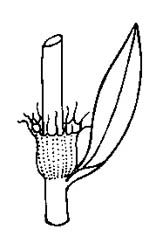 |
 |
Stipules form
When stipules are present, several different shapes (form) of stipules may be present.
The shapes include:
| scale-likeoften more or less translucent, usually significantly reduced in size and frequently more or less triangular in shape |
collar-like stipule is distally truncate such that no clear apex is recognisable, frequently stipules are more or less encircling the twig |
hair-like stipules are greatly reduced and more or less linear (hence, hair-like) |
 |
 |
 |
| leafy stipules more or less similar in shape to a leaf, usually green |
spiny stipules reduced to a more or less sharp, linear point (spine) |
represented by glands stipules modified and glandular |
 |
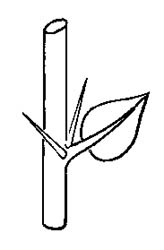 |
 |
Stipules margin
The presence of hairs on the margin of the stipules is recorded as either:
fringed
(fimbriate), hence, hairs present |
not fringed
hence, hairs absent |
 |
 |
Stipules size
| The size of the stipules are classified as either: |
|
large – easily visible to the eye or
small – not easily visible to the eye, often sufficiently small that careful examination is required to view these stipules
|
Stipules persistence
| The stipules may remain on the twigs and hence are described as persistent or they be non-persistent (caducous). |
This feature is recorded as either:
not persistent, or
persistent
|
|
|
